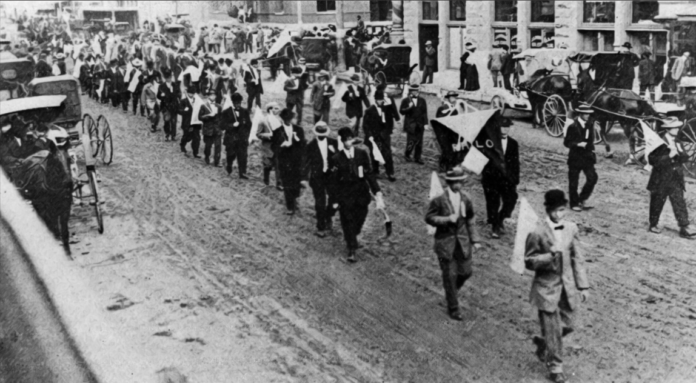
By Emma Weidmann | Staff Writer
Baylor held the nation’s first homecoming celebration in 1909, sparking a tradition that continued for the following 113 years and has spread across the country. Throughout its history, Baylor’s oldest and proudest celebration has changed as much as it has remained constant, Sylvia Hernandez, assistant librarian at the Texas Collection, said.
“Through time, you can see the way that the band is there, the cars are there and when floats were introduced,” Hernandez said. “Now Pigskin is the bigger thing … You’re still getting the same weekend, but you’re getting a bigger emphasis on different activities.”
The first homecoming celebration kicked off with speeches by then-President Samuel Palmer Brooks and Dr. George Truett in Carroll Chapel. While Carroll Library still stands on campus, the chapel burned down in 1922, so opening worship services are now held on Fountain Mall through Vertical and the mass meeting in remembrance of the Immortal Ten.
The parade route in 1909 looked similar to that of today, beginning at Washington and 11th, though it ended in a spot that has changed drastically since.
The Golden Wave Band led the parade of cars with advertising by local businesses. It finished at Carroll Field, where onlookers watched the Bears win the homecoming game against Texas Christian University. Now, the Bill Daniel Student Center stands on the site of that historic win and serves an equally central role in student life.
In a Nov. 26, 1909, edition of the Lariat, the Lariat condemned “foolish and reprehensible” behavior by Baylor and TCU students after the homecoming game, in which students from both schools reportedly destroyed parade decorations downtown. The Lariat chalked up the students’ conduct to “excited impulse” due to the win.
Hernandez said people tend to consider their ancestors to be more proper and straight-edge, but it was actually easier to get away with pranks and antics like these because of the lack of social media.
“They did get a little bit rambunctious,” Hernandez said. “Students are going to be students … Somebody had to see you do it in order to report you doing it … It’s still very well-documented that students did get into shenanigans.”
Literary societies like the all-male Philomathesians and Erisophians and the all-female Calliopean Society held alumni reunions similar to those that sororities and fraternities hold today for homecoming.
“The literary societies can be equated to Greek Life before Greek Life existed here at the university,” Hernandez said. “Seeing the growth over time and meeting new people is how the term ‘Baylor family’ is used. You always want to meet the next generation and see how things are the same but have changed.”
The celebration was not always as inclusive as it is today. In 1909, the university had not yet allowed Black students or any students of color admission. Instead, according to Hernandez, people of color were present on campus in roles of “domestic labor.”
“[The first homecoming] was for the students who came here who were white students,” Hernandez said. “There were people of color on campus who were doing these behind-the-scenes sorts of jobs.”
Since its creation in 1919, The Baylor Chamber of Commerce has turned homecoming into a weeklong event, beginning with the first “Good Will Week” in 1926, meant to deepen the sense of community on campus.
“Homecoming was originally established to welcome back alumni, and 10 years later, Chamber began,” Cordero said. “Our underlying mission is to provide service to Baylor in any way that we can … It’s because we want to serve the Baylor community, that we have held down this tradition for so long. Ultimately, we just want students and anyone at the university to enjoy this tradition just like so many others before have.”





